TYPES OF TRANSMISSION MEDIUMS
The Navy uses many different types of TRANSMISSION MEDIUMS in its electronic applications. Each medium (line or waveguide)
has a certain characteristic impedance value, current-carrying capacity, and physical shape and is designed to meet a particular
requirement.
The five types of transmission mediums that we will discuss in this chapter include PARALLEL-LINE, TWISTED PAIR, SHIELDED
PAIR, COAXIAL LINE, and WAVEGUIDES. The use of a particular line depends, among other things, on the applied frequency, the
power-handling capabilities, and the type of installation. NOTE: In the following paragraphs, we will mention LOSSES several
times. We will discuss these losses more thoroughly under "LOSSES IN TRANSMISSION LINES."
Two-Wire Open Line
One type of parallel line is the TWO-WIRE OPEN LINE illustrated in figure 3-2. This line consists of two wires that are
generally spaced from 2 to 6 inches apart by insulating spacers. This type of line is most often used for power lines, rural
telephone lines, and telegraph lines. It is sometimes used as a transmission line between a transmitter and an antenna or
between an antenna and a receiver. An advantage of this type of line is its simple construction. The principal disadvantages
of this type of line are the high radiation losses and electrical noise pickup because of the lack of shielding. Radiation
losses are produced by the changing fields created by the changing current in each conductor.
Figure 3-2. - Parallel two-wire line.
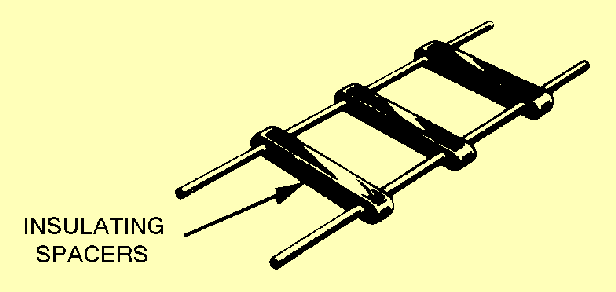
Another type of parallel line is the TWO-WIRE RIBBON (TWIN LEAD) illustrated in figure 3-3. This type of transmission line
is commonly used to connect a television receiving antenna to a home television set. This line is essentially the same as
the two-wire open line except that uniform spacing is assured by embedding the two wires in a low-loss dielectric, usually
polyethylene. Since the wires are embedded in the thin ribbon of polyethylene, the dielectric space is partly air and partly
polyethylene.
Figure 3-3. - Two-wire ribbon type line.
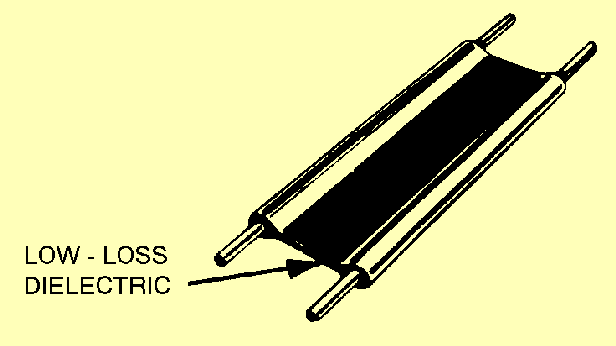
Twisted Pair
The TWISTED PAIR transmission line is illustrated in figure 3-4. As the name implies, the line consists of two insulated
wires twisted together to form a flexible line without the use of spacers. It is not used for transmitting high frequency
because of the high dielectric losses that occur in the rubber insulation. When the line is wet, the losses increase greatly.
Figure 3-4. - Twisted pair.
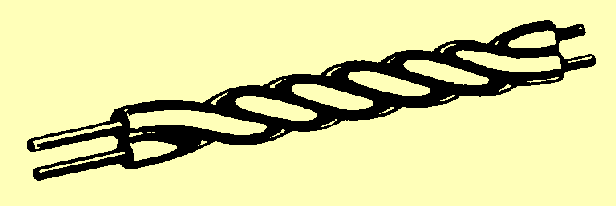
Shielded Pair
The SHIELDED PAIR, shown in figure 3-5, consists of parallel conductors separated from each other and surrounded by a solid
dielectric. The conductors are contained within a braided copper tubing that acts as an electrical shield. The assembly is
covered with a rubber or flexible composition coating that protects the line from moisture and mechanical damage. Outwardly,
it looks much like the power cord of a washing machine or refrigerator.
Figure 3-5. - Shielded pair.
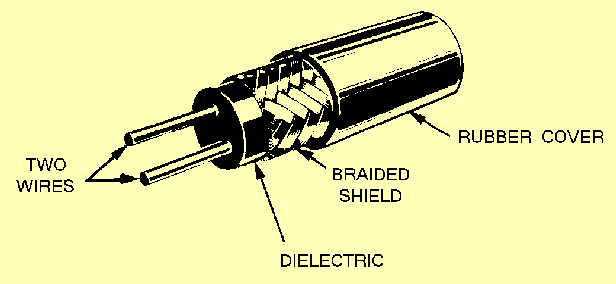
The principal advantage of the shielded pair is that the conductors are balanced to ground; that is, the capacitance between
the wires is uniform throughout the length of the line. This balance is due to the uniform spacing of the grounded shield
that surrounds the wires along their entire length. The braided copper shield isolates the conductors from stray magnetic
fields.
Coaxial Lines
There are two types of COAXIAL LINES, RIGID (AIR) COAXIAL LINE and FLEXIBLE (SOLID) COAXIAL LINE. The physical construction
of both types is basically the same; that is, each contains two concentric conductors.
The rigid coaxial line consists of a central, insulated wire (inner conductor) mounted inside a tubular outer conductor.
This line is shown in figure 3-6. In some applications, the inner conductor is also tubular. The inner conductor is insulated
from the outer conductor by insulating spacers or beads at regular intervals. The spacers are made of pyrex, polystyrene,
or some other material that has good insulating characteristics and low dielectric losses at high frequencies.
Figure 3-6. - Air coaxial line.
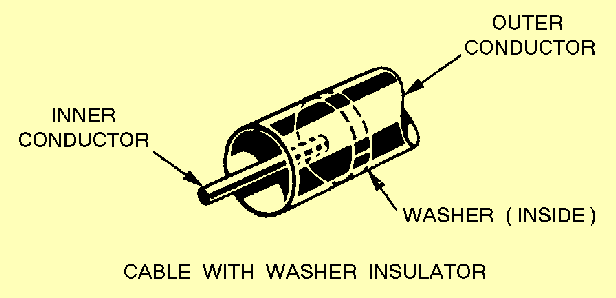
The chief advantage of the rigid line is its ability to minimize radiation losses. The electric and magnetic fields in
a two-wire parallel line extend into space for relatively great distances and radiation losses occur. However, in a coaxial
line no electric or magnetic fields extend outside of the outer conductor. The fields are confined to the space between the
two conductors, resulting in a perfectly shielded coaxial line. Another advantage is that interference from other lines is
reduced.
The rigid line has the following disadvantages: (1) it is expensive to construct; (2) it must be kept dry to prevent excessive
leakage between the two conductors; and (3) although high-frequency losses are somewhat less than in previously mentioned
lines, they are still excessive enough to limit the practical length of the line.
Leakage caused by the condensation of moisture is prevented in some rigid line applications by the use of an inert gas,
such as nitrogen, helium, or argon. It is pumped into the dielectric space of the line at a pressure that can vary from 3
to 35 pounds per square inch. The inert gas is used to dry the line when it is first installed and pressure is maintained
to ensure that no moisture enters the line.
Flexible coaxial lines (figure 3-7) are made with an inner conductor that consists of flexible wire insulated from the
outer conductor by a solid, continuous insulating material. The outer conductor is made of metal braid, which gives the line
flexibility. Early attempts at gaining flexibility involved using rubber insulators between the two conductors. However, the
rubber insulators caused excessive losses at high frequencies.
Figure 3-7. - Flexible coaxial line.
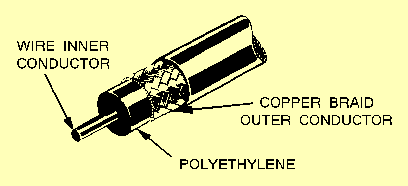
Because of the high-frequency losses associated with rubber insulators, polyethylene plastic was developed to replace rubber
and eliminate these losses. Polyethylene plastic is a solid substance that remains flexible over a wide range of temperatures.
It is unaffected by seawater, gasoline, oil, and most other liquids that may be found aboard ship. The use of polyethylene
as an insulator results in greater high-frequency losses than the use of air as an insulator. However, these losses are still
lower than the losses associated with most other solid dielectric materials.
Waveguides
The WAVEGUIDE is classified as a transmission line. However, the method by which it transmits energy down its length differs
from the conventional methods. Waveguides are cylindrical, elliptical, or rectangular (cylindrical and rectangular shapes
are shown in figure 3-8). The rectangular waveguide is used more frequently than the cylindrical waveguide.
Figure 3-8. - Waveguides.
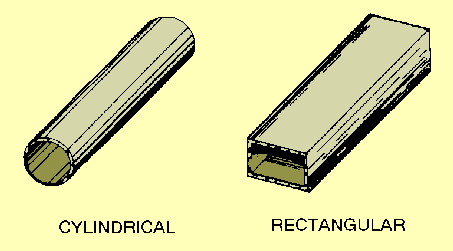
The term waveguide can be applied to all types of transmission lines in the sense that they are all used to guide
energy from one point to another. However, usage has generally limited the term to mean a hollow metal tube or a dielectric
transmission line. In this chapter, we use the term waveguide only to mean "hollow metal tube." It is interesting to
note that the transmission of electromagnetic energy along a waveguide travels at a velocity somewhat slower than electromagnetic
energy traveling through free space.
A waveguide may be classified according to its cross section (rectangular, elliptical, or circular), or according to the
material used in its construction (metallic or dielectric). Dielectric waveguides are seldom used because the dielectric losses
for all known dielectric materials are too great to transfer the electric and magnetic fields efficiently.
The installation of a complete waveguide transmission system is somewhat more difficult than the installation of other
types of transmission lines. The radius of bends in the waveguide must measure greater than two wavelengths at the operating
frequency of the equipment to avoid excessive attenuation. The cross section must remain uniform around the bend. These requirements
hamper installation in confined spaces. If the waveguide is dented, or if solder is permitted to run inside the joints, the
attenuation of the line is greatly increased. Dents and obstructions in the waveguide also reduce its breakdown voltage, thus
limiting the waveguide's power-handling capability because of possible arc over. Great care must be exercised during installation;
one or two carelessly made joints can seriously inhibit the advantage of using the waveguide.
We will not consider the waveguide operation in this module, since waveguide theory is discussed in NEETS, Module 11, Microwave
Principles.
Q.4 List the five types of transmission lines in use today. 
Q.5 Name two of the three described uses of a two-wire open line. 
Q.6 What are the two primary disadvantages of a two-wire open line? 
Q.7 What type of transmission line is often used to connect a television set to its antenna? 
Q.8 What is the primary advantage of the shielded pair? 
Q.9 What are the two types of coaxial lines in use today? 
Q.10 What is the chief advantage of the air coaxial line?
Q.11 List the three disadvantages of the air coaxial line.
Q.12 List the two common types of waveguides in use today.

